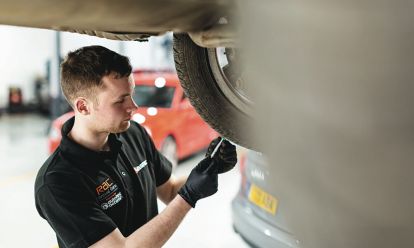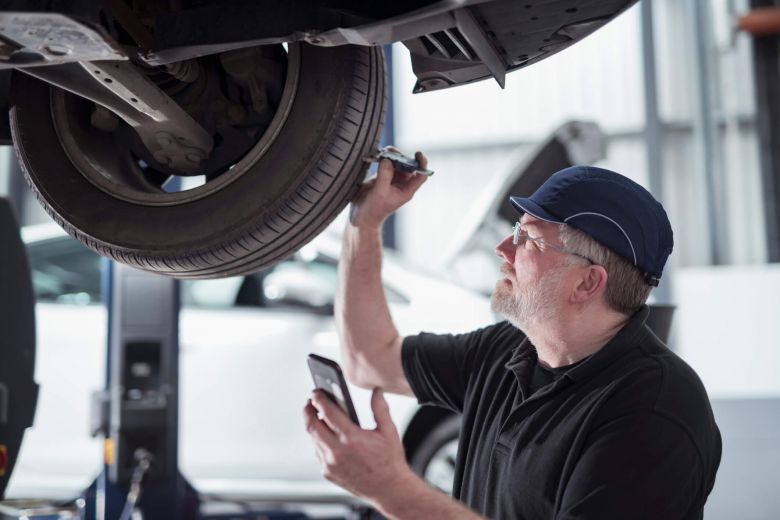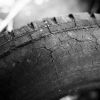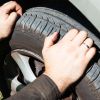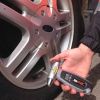Incorrect tyre pressure, excessive wear and tyre damage can all result in serious safety problems for your car. That's why it is important to be aware of tyre maintenance and check your vehicle regularly for the warning signs of illegal tyres.
Tyres are designed to last for thousands of miles – but they can become an afterthought when you are going about your daily life. This guide looks into everything you need to know about staying legal when driving around the UK.
What is a legal car tyre?
In the UK, a legal tyre must meet specific requirements to be considered roadworthy. Here are the key legal requirements for tyres.
- Tread depth: The minimum legal tread depth for a car is 1.6mm across the central three-quarters of the tyre and around the entire circumference. It's recommended to replace tyres when they reach the legal limit and consider replacing them at 3mm for improved safety.
- Condition: Tyres must be free from any bulges, cuts, or other forms of damage that could compromise their structural integrity.
- Type approval: Tyres must be of an appropriate type and have the correct speed and load ratings suitable for the vehicle.
- Run-flat tyres (if fitted): If your vehicle is equipped with run-flat tyres, they must be in good condition and functioning correctly.
- Mixing tyre types: It is generally advisable to avoid mixing tyre types (e.g., radial and cross-ply) on the same axle or across the vehicle unless the vehicle manufacturer specifically permits it.
- Winter tyres: There are no specific legal requirements for using winter tyres. However, if you choose to use them, they must meet certain standards and display the "M+S" (mud and snow) or snowflake symbol on the tyre sidewall.
- Tyre Pressure Monitoring System (TPMS): If your vehicle is equipped with a TPMS, it should be in proper working order.
It's important to note that these requirements may change over time, so it's always a good idea to check with the UK's Driver and Vehicle Standards Agency (DVSA) for the most up-to-date information on legal tyre requirements.
What makes your tyres illegal?
Several factors can make tyres illegal in the UK. According to RAC data, the most common issue is insufficient tread depth. Tyres with a tread depth below the legal limit of 1.6mm across the central three-quarters of the tyre and around the entire circumference are deemed illegal.
Driving with tyres below the legal tread depth can affect the vehicle's grip on the road and increase the risk of accidents.
Also, tyres with visible damage, such as cuts, bulges, or exposed cords, are considered unsafe and may be deemed illegal by police.
Tyres that do not meet the specifications recommended by the vehicle manufacturer, including incorrect type, size, or load and speed rating, can be considered illegal. This also includes mixing types of tyre. For example, using radial and cross-ply designs. This is because it will lead to uneven wear and compromise the vehicle's handling and stability.
It's essential to ensure that your tyres comply with the legal requirements to maintain safety on the road. Regularly inspecting your tyres for damage, checking tread depth, and following the manufacturer's recommendations can help ensure they remain legal.
What does an illegal tyre look like?
Below are some images of what an illegal tyre looks like – make sure your tyres are road legal.
Bald tyres
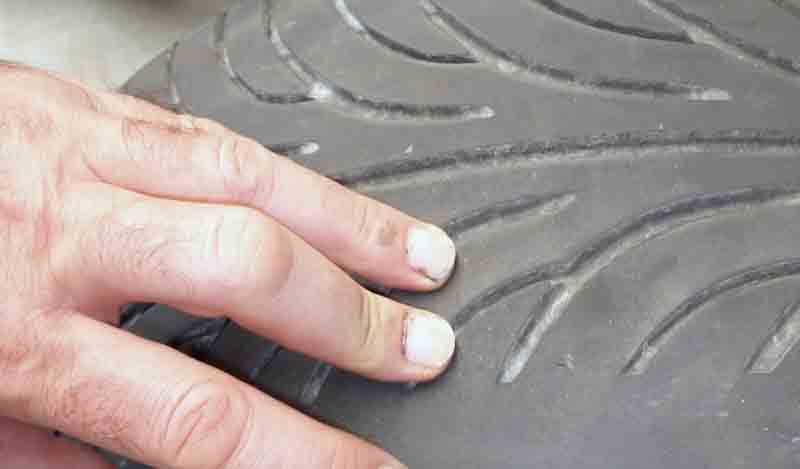
Damaged tyres
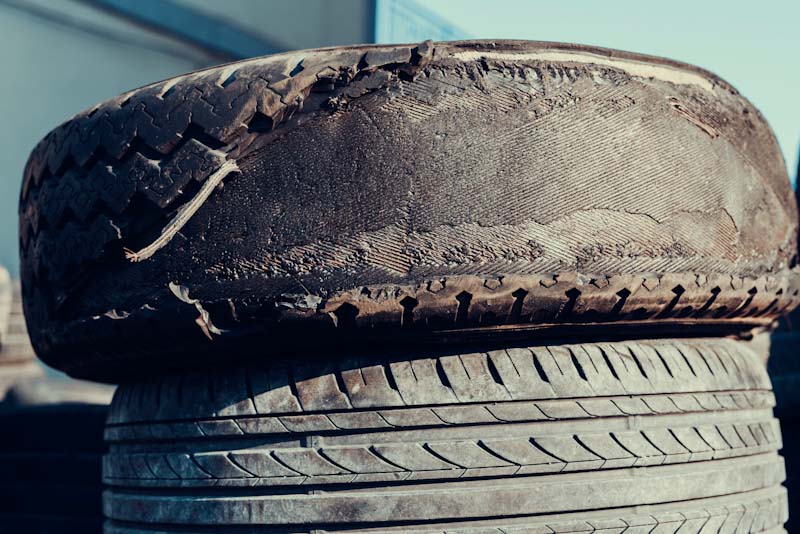
Bulged tyres
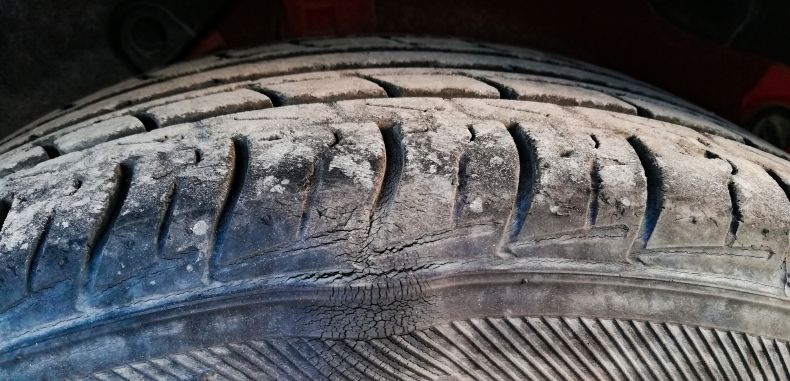
No matter what the condition of your tyres, you need to stay on top of regular car maintenance. It will keep you road legal and all road users safe.
If you are learning to drive, be aware that knowing what a legal or illegal tyre looks like might come up in your driving theory test.
To prepare for the theory test, an app like Driving Theory Test UK is a great place to start, with all necessary learning materials, hazard perception clips and Highway Code info included. You can download it here:
How to test if you have legal tyres
In the UK, the legal minimum tread depth for tyres is 1.6mm across the central three-quarters of the tyre and around the entire circumference. Tread depth refers to the depth of the grooves and patterns on the tyre's surface, which help provide traction and grip on the road.
If the tread depth of a tyre falls below the legal limit at any point across the central three-quarters and around the entire circumference, it is considered illegal.
To test this, you can use a tread depth gauge or look for the tread wear indicators located in the tyre's grooves. These indicators become visible when the tyre tread has worn down to approximately 1.6mm, indicating that the tyre needs to be replaced.
Alternatively, you can take a 20p coin and insert it into the tread grooves on the tyre. If you can't see the outer band on the coin, your tyres are above the legal limit.
It is also illegal to have too much or too little air in your tyres. Check your tyre pressure regularly to make sure you are road legal.
What will the police do if you are caught with illegal tyres?
If you are caught with the incorrect pressure, or with an illegal level of tread depth – you could face police action.
This is also true if you have cracked or bulging tyres, where the damage creates an unsafe environment for all road users.
If you are caught driving with illegal tyres in the UK, the police can take several actions depending on the circumstances:
- Issuing a penalty notice: In some cases, the police may issue a Fixed Penalty Notice (FPN) for having illegal tyres. This typically results in a fine and penalty points on your driving license. The exact amount of the fine and the number of penalty points can vary on the offence.
- Prohibition notice: In more severe cases, the police may issue a Prohibition Notice, which prohibits you from driving the vehicle until the tyres are replaced with legal ones. You would need to have the tyres replaced and provide evidence of the change before being allowed to drive the vehicle again.
- Vehicle impoundment: If the condition of the tyres is deemed extremely dangerous or the vehicle is already subject to other legal issues, the police may impound the vehicle until the necessary repairs are made, including replacing the illegal tyres.
- Court proceedings: In some instances, particularly if the offense is considered serious or repeat offenses occur, the matter may be taken to court. If found guilty, you could face a more substantial fine, increased penalty points, or even disqualification from driving.
It's important to note that the specific actions taken by the police may vary depending on the circumstances and the discretion of the officer involved.
However, driving with illegal tyres is taken seriously as it poses a risk to road safety. It's always best to ensure your tyres meet the legal requirements to avoid any penalties and, most importantly, to ensure your safety and the safety of others on the road.
- Tyre safety – all you need to know
- How to change a tyre in 10 simple steps
- Tyre labels explained – fuel economy, grip and noise ratings
What is the penalty for illegal tyres?
If you drive on damaged or worn tyres, you’re putting everyone’s safety at risk. As well as a hefty fine you could receive penalty points on your licence too.
The penalty for driving with tyres below the legal tread depth limit is a fine of up to £2,500 and three penalty points per tyre.
So, in total, you could face a £10,000 bill.
Fortunately the points do not add up in the same way as the fine does and you would only receive three penalty points for the offence, irrespetive of how many tyres you were penalsied for.
If you’re involved in an accident while driving with defective tyres, an insurance claim could also be invalidated, which means your insurer won't pay out to repair your vehicle.
Want to protect yourself against any losses after an accident? Get legal expenses insurance with RAC Legal Care Plus.
READ MORE: Tyre safety – all you need to know
How long do tyres last?
The lifespan of tyres can vary depending on various factors such as the tyre type, driving conditions, maintenance, and individual driving habits.
Generally, tyres are designed to last between 20,000 and 40,000 miles or one to three years.
Knowing how long your tyres last is important, but regularly checking them is integral to car ownership.
Here are some guidelines regarding tyre lifespan.
- Mileage: Most tyres have a mileage rating provided by the manufacturer. This rating gives an estimate of how long the tyres are expected to last under normal driving conditions. It's important to check the tyre manufacturer's recommendations for the specific tyre model you have.
- Time: Tyres also have a recommended service life, typically indicated by the tyre manufacturer. Even if the tyres have not reached the mileage limit, it is generally recommended to replace tyres that are older than four years, regardless of the remaining tread depth. Over time, tyres can deteriorate due to factors like exposure to the elements, heat, and aging of the rubber compound.
- Driving conditions: Driving habits and conditions can significantly affect tyre lifespan. Aggressive driving, frequent braking, and driving on rough roads can wear out tyres faster. Similarly, driving in extreme weather conditions, such as high temperatures, can also affect tyre longevity.
- Maintenance: Proper tyre maintenance is crucial for maximising their lifespan. Regularly checking and maintaining the correct tyre pressure, getting tyre rotations and alignments, and performing visual inspections for damage or wear can help extend tyre life.
If you are looking for replacements for your vehicle, check out RAC Tyres.
Motorbike tyres
If you are driving a motorcycle instead of a car, then the rules are slightly different.
Whilst 1.6mm is the right size for cars, the limit for motorcycles over 50cc is 1mm across 3/4 of the tyre around the whole circumference.
For mopeds, the original tread only has to be visible.
What does the future hold?
Drivers should now be aware or the importance of tyre safety and what to look out for.
But as everything within the motoring world, the sector is constantly evolving.
The next milestone within the tyre industry is the potential introduction of a ‘tyre tax’.
As the world looks to cut emissions, this is the latest scheme that is being discussed. Essentially, it means that when tyres break down, they release a range of particles, from visible pieces of tyre rubber to nanoparticles. These particles may contain a range of toxic chemicals as well as metals like zinc and lead. As a result, discussions have begun on what this could look like.
Nothing has been announced or confirmed by the Government, but it is worth keeping an eye on for the months and years ahead.
No matter whether this gets implemented, tyre safety and remaining road legal are the most important things to remember before you get behind the wheel of a vehicle.
Service, repair or MOT?
You can trust the RAC with our local approved garages and NEW mobile mechanics.
